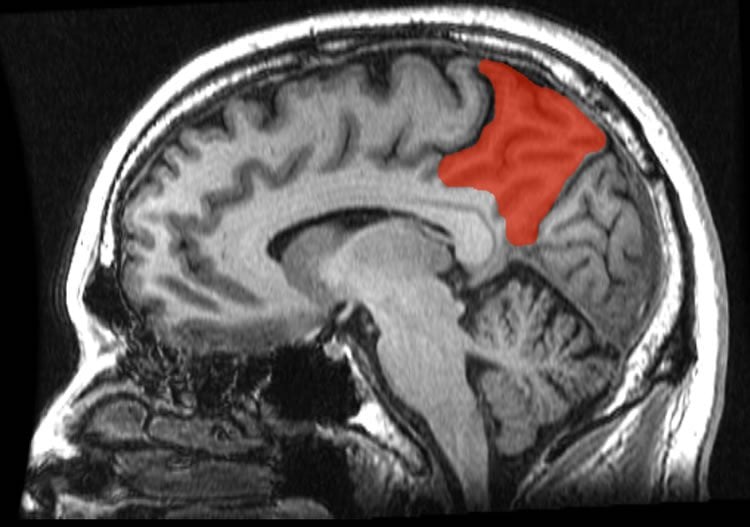Summary: According to a new study published in the Journal of Abnormal Psychology, the brains of women with the eating disorder Bulimia Nervosa respond differently to images of sugary and high-fat foods following a stressful situation than those without the disorder. Brain scans reveal bulimic women have decreased blood flow to the precuneus, an area of the brain associated with self-criticism, when presented with images of food following a stressful math test. The findings provide support to current theories that binge eating may provide an alternative focus to negative self-reflections.
Source: Neuroscience News
A new study published by the American Psychological Association reports women who suffer from Bulimia Nervosa respond differently to images of food following a stressful event than their peers without the eating disorder.
In a new neuroimaging study, researchers discovered women with bulimia had decreased blood flow in an area of the brain associated with self-reflection. By contrast, in women who do not suffer from bulimia, researchers noted an increased blood flow to the same brain area. The researchers concluded that those with bulimia could be using food to avoid negative associations about themselves.
Bulimia nervosa is an eating disorder characterized by periods of overeating or binging, followed by purging. Purging behaviors can include induced vomiting, excessive exercise, and laxative use. Unlike anorexia, those with bulimia can maintain a normal weight, or may, in some cases, be overweight. In many cases, purging may be used to help control weight and prevent additional weight gain.
It is known that stress may be a trigger for binge eating in those with bulimia. However, very little is known about how those with the eating disorder respond to, and process, food cues.
In a series of experiments, researchers presented 20 test subjects with the same meal. Ten of the participants had a history of bulimia, while the other ten reported no instances of eating disorders. One hour proceeding the meal, all participants entered an MRI scanner and were first shown a selection of neutral images, followed by images of high fat and high sugar foods.
After the initial brain scans, subjects were asked to complete a difficult math problem designed to illicit stress and negatively impact self-confidence. The participants reentered the MRI machine and were shown different images of unhealthy foods. While in the scanner, the women were asked to rate their stress levels and food cravings.
Researchers noted every participant experienced stress following the math problem. All of the women reported their stress levels were reduced after seeing the images of food while in the MRI machine the second time. Each participant also reported food cravings after seeing the reintroduced images of high-fat foods.
While the patterns of self-reported cravings and stress reduction were similar across both the bulimic group and those without the eating disorder, the MRI scans showed differences in neural activity between the groups. In those with bulimia, researchers witnessed decreased blood flow to the precuneus, an area of the brain associated with thinking about the self. The brain scans of women with no history of bulimia showed an increase in blood flow to that brain area.
Sarah Fischer, co-author of the study said: “We would expect to see increased blood flow in this region when someone is engaged in self-reflection, rumination or self-criticism”.
In a follow-up study, researchers had 17 bulimic women complete the same tasks set out in the first experiment. The researchers report the results of the second study were the same as the first. The women reported increased stress levels after the math test, followed by reduced stress and increased cravings on seeing the food cues. Additionally, there was a correlation between both groups of bulimic subjects, with reduced blood flow to the precuneus when viewing food cues after participating in the stressful math test.

Brittany Collins, lead author of the study, said the decreased blood flow to the precuneus, as seen in the bulimic cohort, could mean the introduction of food may close off critical thinking. This allows those with eating disorders to have something other to focus on, rather than having to deal with their perceived shortcomings.
The findings provide support for a common theory that states binge eating could provide an alternative focus for negative emotions, which often occur as a result of stressful situations.
Collins said, “Our findings are consistent with the characterization of binge-eating as an escape from self-awareness and support the emotion regulation theories that suggest that women with bulimia shift away from self-awareness because of negative thoughts regarding performance or social comparisons and shift focus to a more concrete stimulus, such as food.”
Findings from this study shed light on the neurobiological underpinnings of why women with bulimia use food as a distractor from stress.
The authors say that further studies are required to confirm the preliminary results.
This study will appear in a special section of the July 2017 edition of the Journal of Abnormal Psychology.
Source: Victoria Driscoll – Neuroscience News
Image Source: NeuroscienceNews.com image is in the public domain.
[cbtabs][cbtab title=”MLA”]Neuroscience News “Bulimic Brains Respond Differently to Food Cues Following Stressful Events.” NeuroscienceNews. NeuroscienceNews, 10 July 2017.
<https://neurosciencenews.com/bulimia-blood-flow-stress-7048/>.[/cbtab][cbtab title=”APA”]Neuroscience News (2017, July 10). Bulimic Brains Respond Differently to Food Cues Following Stressful Events. NeuroscienceNew. Retrieved July 10, 2017 from https://neurosciencenews.com/bulimia-blood-flow-stress-7048/[/cbtab][cbtab title=”Chicago”]Neuroscience News “Bulimic Brains Respond Differently to Food Cues Following Stressful Events.” https://neurosciencenews.com/bulimia-blood-flow-stress-7048/ (accessed July 10, 2017).[/cbtab][/cbtabs]







